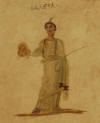Search:: Artists Alphabetically Symbolism 50 Greatest Paintings Art Movements 100 Greatest Painters
Classical Roman Painting
The Roman Style
The Romans like the Greeks loved beauty and art. Upper income people had every wall of their home decorated with beautiful murals. Romans favored nature scenes with birds in flight, fish, dogs and exotic animals. Mythological scenes and philosophers in contemplation were also popular. Soc, According to noted historian, Hendrik van Loon "The Romans, like their Carthaginian rivals, were too busy administering other people and making money to have much love for “useless and unprofitable” adventures of the spirit. They conquered the world and built roads and bridges but they borrowed their art wholesale from the Greeks. They invented certain practical forms of architecture which answered the demands of their day and age. But their statues and their histories and their mosaics and their poems were mere Latin imitations of Greek originals. Without that vague and hard-to- define something which the world calls “personality,” there can be no art and the Roman world distrusted that particular sort of personality. The Empire needed efficient soldiers and tradesmen. The business of writing poetry or making pictures was left to foreigners."
Roman painting Techniques and Formula
Roman artists created their masterpieces using homemade pigments. Pigments were made according to ancient Greek recipes. Artists used many different ingredients to achieve the desired colors, including burnt apple seeds, pulverized semiprecious stones such as lapis lazuli, charcoal, animal and human bones, naturally occurring earth pigments such celadonite and chlorite, pomegranate juice and ground up ibulio beetles. Each artist mixing up his own a batch to use as needed.
Egg tempera is a radiant, semi-translucent paint that dries almost
immediately. The process of setting up the paint was time consuming and
technical. The artist used 1 egg, 1 tsp. raw olive oil, a few drops if
vinegar added to ground pigment. The process to make just one color
took about 30 minutes. Brushes were made from squirrel hair, hogs
bristle and cat whiskers.
Artists painted on portable panels and directly onto the plaster walls
(fresco) of their rooms. For interior rooms Romans loved
trompe-l'oeil effects and mythological and erotic scenes. Frescoes
uncovered under volcanic ash 2,000 years ago in Pompeii depict animated
bedroom activities involving multiple partners. Many of the
pigments were extremely toxic causing the person mixing them to have
oozing sores that never healed, patches of baldness, scorched lungs and
in a few short years a painful death. Old slaves were usually employed
to grind up the pigments and mix up the binders.
Classical Roman paintings mainly survived in cities that were buried under the volcanic ash thus preserving the art.
☼☼☼☼☼☼☼☼☼☼
☼☼☼☼☼
Require more facts and information about Roman Art? Poke around every nook and cranny of the known universe for information this subject. Search Here
If you feel you have worthwhile information you would like to contribute we would love to hear from you. We collect essential biographical information and artist quotes from folks all over the globe and appreciate your participation. When submitting please, if possible, site the source and provide English translation. Please submit your comment to the editor, via e-mail and if possible site the source. Thank you!
copyright 1999 - 2011 historyofpainters.com
© HistoryofPainters.com If you like this page and wish to share
it, you are welcome to link to it, with our thanks.
Every art and every investigation, and likewise every practical pursuit or undertaking, seems to aim at some good: hence it has been well said that the Good is That at which all things aim. - Aristotle

